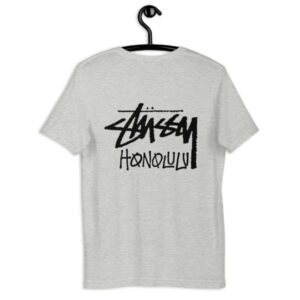When choosing fabrics for clothing, we often focus on color, texture, and design. But one aspect that greatly affects a fabric’s quality and wearability is GSM — Grams per Square Meter. Understanding what is GSM in fabric is crucial if you’re looking to make the best fabric choice for your clothing, whether it’s for custom t-shirts, workwear, or everyday wear.
This guide will explain what GSM means, how it affects fabric quality, and how to use this knowledge to pick the perfect fabric for your needs.
What Is GSM in Fabric?
GSM refers to the weight of the fabric. It’s measured by how much a square meter of fabric weighs in grams. The higher the GSM number, the thicker and heavier the fabric is. For example, a cotton t-shirt fabric with 180 GSM is lighter than a fleece hoodie with 300 GSM.
But why should you care about GSM? Understanding this measurement helps you make better choices when selecting fabric for various types of clothing — especially when you’re looking for quality, comfort, and durability.
How GSM Affects Fabric Performance
1. Lightweight Fabrics: 100–150 GSM
Fabrics in this range are lightweight and breathable, making them ideal for hot weather. They’re soft, airy, and comfortable for casual wear. Think of t-shirts, thin shirts, or summer dresses. Here’s how it impacts clothing:
- Comfort: Great for breathable clothing that you wear during the summer.
- Durability: These fabrics may wear out faster than heavier fabrics, especially if exposed to harsh washing or frequent use.
- Transparency: Lighter GSM fabrics can be slightly see-through, so they may require additional layering or lining.
2. Mid-Weight Fabrics: 150–200 GSM
Fabrics in this range strike a balance between comfort and durability. Many custom t-shirts and regular shirts are made with fabrics around 160–180 GSM. This GSM is great for everyday use as it’s still light enough for breathability but strong enough for long-term wear like a men’s oversized tee.
- Comfort: Comfortable for all-day wear in a variety of conditions.
- Durability: Good durability for regular washing and daily activities.
- Versatility: Perfect for a range of clothing, including casual wear, workwear, and uniforms.
3. Heavyweight Fabrics: 200–350 GSM
Fabrics over 200 GSM are considered heavy-duty. These are used for winter clothing, jackets, sweatshirts, or fleece. Heavier GSM fabrics trap warmth, making them perfect for cold weather. They also offer greater longevity and strength.
- Comfort: Heavier fabrics may not always be as breathable, but they offer comfort and insulation in cold weather.
- Durability: These fabrics last longer and are more resistant to wear, making them ideal for durable clothing like hoodies or jackets.
- Flexibility: Some heavier fabrics can feel stiff, so they may not offer the same flexibility as lighter ones.
Why GSM Matters for Clothing Selection
Understanding GSM helps you make informed decisions about what you wear and where you wear it. Here’s how to use this information:
1. Choosing Clothing for Comfort
If you want a breathable, comfortable t-shirt for summer, you’ll want to pick a fabric with a lower GSM (100–150). On the other hand, if you need warmth and durability for a hoodie or jacket, you’ll choose a fabric with a higher GSM (200–350).
2. Ensuring Durability
Heavier fabrics with higher GSM numbers generally last longer and are more resistant to damage from washing. For workwear, uniforms, or outdoor gear, opting for fabrics in the 200–350 GSM range makes sense. These fabrics will resist wear and tear much better than lighter fabrics.
3. Understanding Fabric Weight for Printing
For custom clothing or promotional t-shirts, knowing GSM helps ensure you get the right fabric for printing. Fabric that is too light (below 150 GSM) might not hold prints well, and heavy fabrics can make the design feel bulky. Finding the right GSM ensures that your t-shirts are both high quality and suitable for printing.
How GSM Impacts Fabric Feel and Quality
Knowing GSM not only helps with the garment’s durability but also its feel against the skin.
1. Softness vs. Stiffness
Lighter fabrics tend to be softer and more flexible, which is why they’re often used in shirts, blouses, or casual wear. On the other hand, heavier fabrics like denim or fleece, while durable, can feel stiff initially.
2. Breathability
If you’re looking for breathable clothing that keeps you cool, a lower GSM fabric (like 100–150 GSM) works best. These fabrics allow air to circulate and keep the body ventilated, which is perfect for warmer climates.
3. Texture
The texture of a fabric can vary depending on GSM. A higher GSM fabric may feel thicker and more substantial, which is great for warmth but might feel less “flowy” than lighter materials.
Ideal GSM for Different Clothing Types
Here’s a breakdown of the ideal GSM for various clothing types:
i. T-Shirts & Casual Tops — 150–180 GSM
Perfect for everyday wear and casual settings. Provides a balance of comfort and durability, allowing for breathability while maintaining shape.
ii. Hoodies & Sweatshirts — 250–350 GSM
Heavyweight fabrics that trap warmth and provide a cozy fit. Great for cold weather and loungewear.
iii. Workwear & Uniforms — 180–250 GSM
These fabrics are durable and comfortable for all-day wear. Ideal for uniforms and jobs that require physical activity.
iv. Summer Clothing (Dresses, Tank Tops) — 100–150 GSM
Ideal for staying cool and comfortable in the heat. These fabrics are light, soft, and perfect for summer wear.
Conclusion
Now that you know what is GSM in fabric, you can make better choices for your wardrobe, workwear, or business uniforms. Whether you’re looking for lightweight, breathable shirts for the summer or durable, heavyweight fabrics for winter, GSM is a crucial factor in fabric selection.
Choosing the right GSM ensures that your clothes feel great, look professional, and last longer, no matter the purpose or season.



